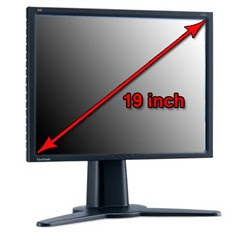Monday, August 8, 2011
16 Must to Know LCD/LED TV Related Terminologies
Old CRT TVs are out of date box in this world. It has been found that more than 60% of the world population is using LCD/LED TVs these days and remaining are opting to upgrade their Old TV boxes. Recently one of my friend went to purchase LCD/LED TV and boggled up with some of the technical words. So before buying LCD/LED TV we should be aware of couple of terms. One of the critical thing is LCD and LED categorizing.
Many of the people still thinks LED TV is far better than LCD TV. So let us start from this point. An LED TV is nothing but an LCD which uses LED back-lighting. TV manufactures has hyped this topic and advertise this sort of display as LED display. This not true LED display but is often called so. The basic difference between the two is that an LED TV uses light emitting diodes for the backlighting, where as an LCD uses fluorescent lamps as backlights. There are two types of LED TV backlighting Edge lit and full array.
1. Screen Size
Length of TV diagonally measured.
2. Aspect Ratio
Ratio of the TV width compared to height. e.g. 16:9

3. Resolution
More number of pixels = the greater the picture quality. e.g. 1920(H) x 1080(V)
The primary difference between Full HD and HD Ready TVs is resolution. Resolution of a Full HD TV is double of that of a HD Ready TV.
Resolution of Standard Definition (Conventional) TVs is 720 H x 480 V = less than 1 million pixels.
Resolution of HD Ready TVs is 1366 H x 768 V = 1 million pixels
Resolution of Full HD TVs is 1920 H x 1080 V = 2 million pixels.
* H = number of Horizontal pixels, V = number of vertical pixels

This animation demonstrates the interline twitter effect. On the left are two progressive scan images. Center are two interlaced images. Right are two images with line doublers. Top are original resolution, bottom are with anti-aliasing. The two interlaced images use half the bandwidth of the progressive one. The interlaced scan (right) precisely duplicates the pixels of the progressive image (left), but interlace causes details to twitter. A line doubler operating in "bob" (interpolation) mode would produce the images at far right. Real interlaced video blurs such details to prevent twitter, as seen in the bottom row, but such softening (or anti-aliasing) comes at the cost of resolution. But even the best line doubler could never restore the bottom center image to the full resolution of the progressive image. Note – Because the frame rate has been slowed down by a factor of 3, you will notice additional flicker in simulated interlaced portions of this image.
4. Dynamic Contrast Ratio
The difference between the brightest whites and darkest blacks a TV can show. e.g. 1,000,000:1

5. Viewing Angle
The max viewable angle when viewing left to right. LCD/LED TV which offers closer to 180* are better.

6. Edge lit LED
Refers to the placements of LEDs along the edges of an LCD display. Due to such arrangements the edges might appear to be brighter than the rest of the picture. Edge lit panels are slimmer in dimensions but can also cause bleeding of light around the edges.

7. Full Array
Refers to arrangement of LEDs which are placed in a full matrix or array, this gives constant and flat back-lighting.

8. Bleeding
LCDs block out redundant light coming from their backlit source, bleeding happens when the back-light behind the LCD surface is not 100% blocked. This results some areas to appear lighter than the rest especially on a dark or black background. Fact is that, almost all LCDs suffer some amount of bleeding.

9. Response Time
Latency or response rate means how quickly the screen can refresh a video image. It basically means the rate at which the LCD can display moving images. It is generally measured in milli seconds (ms) and you should look for TVs with faster response time.
10. Refresh Rate
The number of times your LCD screen refreshes itself per second is known as refresh rate giving you clear, uninterrupted image. Generally the refresh rate is measured in Hertz(Hz). A refresh rate of 120 or 240 Hz refers to the number of times a frame is drawn each second.
11. Ambilight
Philips is an Inventor of Ambilight, refers to the ambient light which is generated corresponding to the video content currently being played on the screen. This effect gives you a feel of a much larger and immersive TV screen.

12. Ghosting
Appearance of a false image on the screen refers to ghosting. This generally happens when a previous image displayed on the screen can still be seen.

13. Bezel
A bezel refers to the outside edges of a Liquid crystal display screen or any screen for that matter.

14. 1080i and 1080p displays
Video mode displaying 1080 lines of vertical resolution is written in shorthand as 1080p, the ‘p’ stands for progressive scan where as on the other hand a 1080i display is shown in 16:9 aspect ratio which gives a screen resolution of 1920 x 1080 pixels. Here the i stands for interlaced.

15. Progressive scan
Also known as non-interlaced scanning is a method of displaying or transmitting a video images in which all the lines of each frames are drawn in a sequence.
16. Interlaced video
This form of transmitting or storing moving images scans only the odd lines, then the even lines of each frame are drawn alternately.

So, these are the common LCD/LED terms used by the manufacturers. The Ghosting, bleeding are problems that commonly seen in displays. I hope this article will be helpful for the next visit to a TV shop. Have a Happy Weekend.
 Posted in: How-Tos
Posted in: How-Tos






 1:11 AM
1:11 AM
 Khyati
Khyati


















0 Comments:
Post a Comment